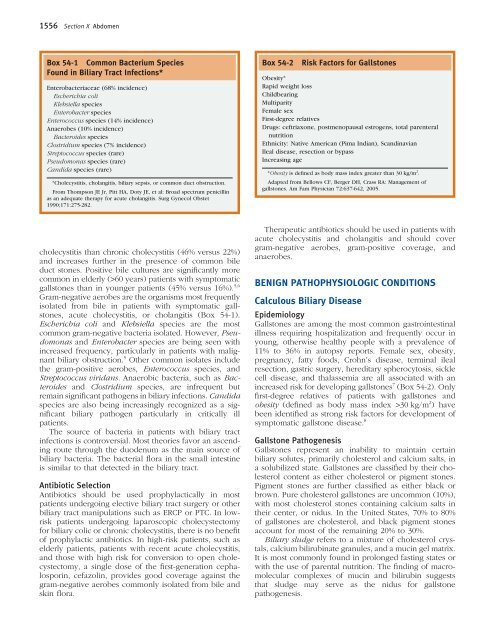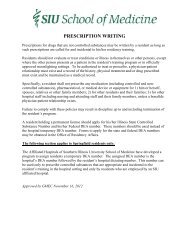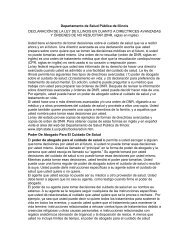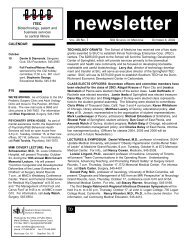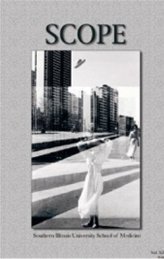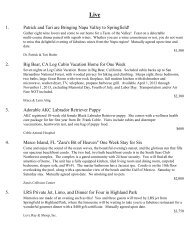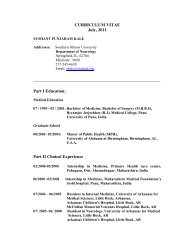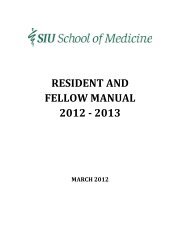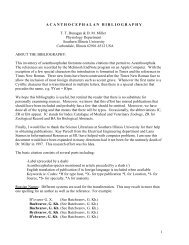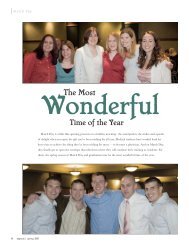Ch. 54 – Biliary System
Ch. 54 – Biliary System
Ch. 54 – Biliary System
You also want an ePaper? Increase the reach of your titles
YUMPU automatically turns print PDFs into web optimized ePapers that Google loves.
1556 Section X Abdomen<br />
Box <strong>54</strong>-1 Common Bacterium Species<br />
Found in <strong>Biliary</strong> Tract Infections*<br />
Enterobacteriaceae (68% incidence)<br />
Escherichia coli<br />
Klebsiella species<br />
Enterobacter species<br />
Enterococcus species (14% incidence)<br />
Anaerobes (10% incidence)<br />
Bacteroides species<br />
Clostridium species (7% incidence)<br />
Streptococcus species (rare)<br />
Pseudomonas species (rare)<br />
Candida species (rare)<br />
*<strong>Ch</strong>olecystitis, cholangitis, biliary sepsis, or common duct obstruction.<br />
From Thompson JE Jr, Pitt HA, Doty JE, et al: Broad spectrum penicillin<br />
as an adequate therapy for acute cholangitis. Surg Gynecol Obstet<br />
1990;171:275-282.<br />
cholecystitis than chronic cholecystitis (46% versus 22%)<br />
and increases further in the presence of common bile<br />
duct stones. Positive bile cultures are signifi cantly more<br />
common in elderly (>60 years) patients with symptomatic<br />
gallstones than in younger patients (45% versus 16%). 5,6<br />
Gram-negative aerobes are the organisms most frequently<br />
isolated from bile in patients with symptomatic gallstones,<br />
acute cholecystitis, or cholangitis (Box <strong>54</strong>-1).<br />
Escherichia coli and Klebsiella species are the most<br />
common gram-negative bacteria isolated. However, Pseudomonas<br />
and Enterobacter species are being seen with<br />
increased frequency, particularly in patients with malignant<br />
biliary obstruction. 5 Other common isolates include<br />
the gram-positive aerobes, Enterococcus species, and<br />
Streptococcus viridans. Anaerobic bacteria, such as Bacteroides<br />
and Clostridium species, are infrequent but<br />
remain signifi cant pathogens in biliary infections. Candida<br />
species are also being increasingly recognized as a signifi<br />
cant biliary pathogen particularly in critically ill<br />
patients.<br />
The source of bacteria in patients with biliary tract<br />
infections is controversial. Most theories favor an ascending<br />
route through the duodenum as the main source of<br />
biliary bacteria. The bacterial fl ora in the small intestine<br />
is similar to that detected in the biliary tract.<br />
Antibiotic Selection<br />
Antibiotics should be used prophylactically in most<br />
patients undergoing elective biliary tract surgery or other<br />
biliary tract manipulations such as ERCP or PTC. In lowrisk<br />
patients undergoing laparoscopic cholecystectomy<br />
for biliary colic or chronic cholecystitis, there is no benefi t<br />
of prophylactic antibiotics. In high-risk patients, such as<br />
elderly patients, patients with recent acute cholecystitis,<br />
and those with high risk for conversion to open cholecystectomy,<br />
a single dose of the fi rst-generation cephalosporin,<br />
cefazolin, provides good coverage against the<br />
gram-negative aerobes commonly isolated from bile and<br />
skin fl ora.<br />
Box <strong>54</strong>-2 Risk Factors for Gallstones<br />
Obesity*<br />
Rapid weight loss<br />
<strong>Ch</strong>ildbearing<br />
Multiparity<br />
Female sex<br />
First-degree relatives<br />
Drugs: ceftriaxone, postmenopausal estrogens, total parenteral<br />
nutrition<br />
Ethnicity: Native American (Pima Indian), Scandinavian<br />
Ileal disease, resection or bypass<br />
Increasing age<br />
*Obesity is defi ned as body mass index greater than 30 kg/m2 .<br />
Adapted from Bellows CF, Berger DH, Crass RA: Management of<br />
gallstones. Am Fam Physician 72:637-642, 2005.<br />
Therapeutic antibiotics should be used in patients with<br />
acute cholecystitis and cholangitis and should cover<br />
gram-negative aerobes, gram-positive coverage, and<br />
anaerobes.<br />
BENIGN PATHOPHYSIOLOGIC CONDITIONS<br />
Calculous <strong>Biliary</strong> Disease<br />
Epidemiology<br />
Gallstones are among the most common gastrointestinal<br />
illness requiring hospitalization and frequently occur in<br />
young, otherwise healthy people with a prevalence of<br />
11% to 36% in autopsy reports. Female sex, obesity,<br />
pregnancy, fatty foods, Crohn’s disease, terminal ileal<br />
resection, gastric surgery, hereditary spherocytosis, sickle<br />
cell disease, and thalassemia are all associated with an<br />
increased risk for developing gallstones 7 (Box <strong>54</strong>-2). Only<br />
fi rst-degree relatives of patients with gallstones and<br />
obesity (defi ned as body mass index >30 kg/m 2 ) have<br />
been identifi ed as strong risk factors for development of<br />
symptomatic gallstone disease. 8<br />
Gallstone Pathogenesis<br />
Gallstones represent an inability to maintain certain<br />
biliary solutes, primarily cholesterol and calcium salts, in<br />
a solubilized state. Gallstones are classifi ed by their cholesterol<br />
content as either cholesterol or pigment stones.<br />
Pigment stones are further classifi ed as either black or<br />
brown. Pure cholesterol gallstones are uncommon (10%),<br />
with most cholesterol stones containing calcium salts in<br />
their center, or nidus. In the United States, 70% to 80%<br />
of gallstones are cholesterol, and black pigment stones<br />
account for most of the remaining 20% to 30%.<br />
<strong>Biliary</strong> sludge refers to a mixture of cholesterol crystals,<br />
calcium bilirubinate granules, and a mucin gel matrix.<br />
It is most commonly found in prolonged fasting states or<br />
with the use of parental nutrition. The fi nding of macromolecular<br />
complexes of mucin and bilirubin suggests<br />
that sludge may serve as the nidus for gallstone<br />
pathogenesis.


